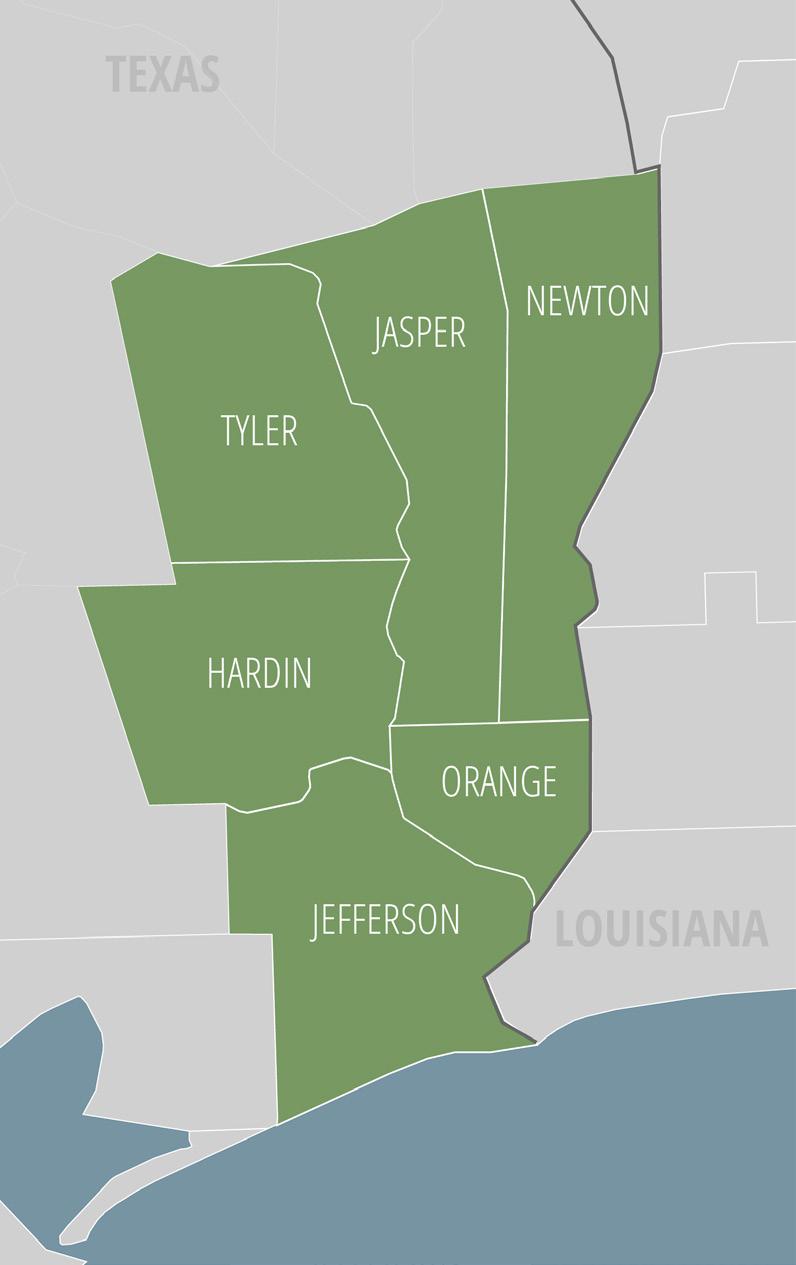
4 minute read
EXECUTIVE SUMMARY
BEAUMONT-PORT ARTHUR REGION SUMMARY

KEY FINDINGS
The Situation
The regional employment base never recovered from the Great Recession, and it was hard-hit by the Pandemic—faced with the double whammy of the economic shutdown and the impact of sluggish demand for oil. Though the manufacturing and construction sectors grew in the years leading up to the Pandemic, the healthcare and retail sectors contracted, which was unusual in a region that was adding population. All four of these primary sectors contracted during the Pandemic and are expected to lose additional jobs over the next five years, except healthcare, which is expected to experience modest gains. This past performance and the future prospects of the primary industries are causes for concern. Persistently high unemployment, even during a historically long period of expansion in other parts Texas and the US, increases the risk of unemployed workers dropping out of the labor force completely or seeking employment in areas of higher economic opportunity. Economic Drivers
The Beaumont-Port Arthur region has a welldefined cluster of activities related to the petrochemical industry and maritime ports. This specialization can be seen in the regional industry and occupational strengths as well as workforce demand. The region’s other economic drivers include healthcare and nonresidential construction. Workforce Demand
Middle-skill jobs—those that require at least a high school diploma but less than a four-year degree— hold the largest share of the employment base, accounting for 42 percent of all jobs in 2020. However, the number of high-skill jobs has been growing is creating opportunity for more workers with higher levels of educational attainment. Middle-wage jobs— those that pay, on average, between $15 and $45 per hour—accounted for 65 percent of all jobs in 2020. The share of middle-wage jobs has been declining and is expected to continue as low-wage and high-wage jobs gain ground. A wide range of middle and highskill jobs that pay more than $15 an hour is expected to be high in-demand over the next five years. These include various occupations in business and operations; education and training; healthcare; computer and mathematical; and skilled trades and production. Most of the high-skill occupations face below average automation risk; middle-skill occupations are more likely to face higher than average automation risk. Educational Infrastructure and Alignment
The region has more than 30 school districts and 3 public higher education institutions. Of the nearly 5,000 high school graduates from regional school districts that can be tracked, 70 percent are employed in Texas in the fall semester after graduation. Almost two-thirds of these recent graduates are employed in retail or accommodations and food services. The top destinations for the 60 percent of regional high school graduates that enroll in higher education are Lamar University, Lamar Institute of Technology, and Lamar State College. In other words, many high school graduates stay local and either work, go to college, or both. Lamar University is the largest source of degrees in the region, but Lamar Institute of Technology and Lamar State College are also important sources of talent. Together, these public institutions graduate more than enough students to fill entry-level openings requiring postsecondary degrees. The degrees’ fields of study align fairly well with the career clusters of the occupations that require them. It should be noted that only about one-third of the students at Lamar University are from the region and may be less likely to seek employment in the region upon graduation.
COUNTIES

KEY STATISTICS
463,359
Population (2019)
+0.1%
Population Change (2014-2019)
186,229
Jobs (2020)
101,035
Openings (2021-2026)
EMPLOYMENT BY INDUSTRY
Healthcare Manufacturing Retail Trade Construction Education Accommodation & Food Services Government Other Services (except Public Administration) Administrative & Support Services Professional, Scientific, & Technical Services Transportation & Warehousing Wholesale Trade Finance & Insurance Real Estate & Rental & Leasing Arts, Entertainment, & Recreation Agriculture, Forestry, Fishing & Hunting Information Mining, Quarrying, & Oil & Gas Extraction Management of Companies & Enterprises Utilities 9,851 8,146 7,929 6,370 5,832 4,744 2,698 1,170 1,089 982 22,614 22,502 22,162 21,092 17,698 15,429 13,434
910 828 747
TOP HIGH-DEMAND, HIGH-WAGE JOBS*
OCCUPATION
1. Heavy & Tractor-Trailer Truck Drivers 2. General & Operations Managers 3. First-Line Supervisors of Food Prep. & Serving Workers 4. First-Line Supervisors of Retail Sales Workers 5. Maintenance & Repair Workers, General 6. First-Line Supvrs. of Construction Trades & Extraction Workers 7. Bookkeeping, Accounting, & Auditing Clerks
OPENINGS (2021-2026)
1,526 1,204 973 953 838 832 829
8. Carpenters
802 9. Sales Reps., Wholesale & Mfg., Except Technical & Scientific Products 779 10. Plumbers, Pipefitters, & Steamfitters 776 11. Petroleum Pump System Operators, Refinery Operators, & Gaugers 769 12. Electricians 760 13. Registered Nurses 710 14. Welders, Cutters, Solderers, & Brazers 679 15. Elementary School Teachers, Except Special Education 672
Source: Emsi 2021.2 – QCEW Employees, Non-QCEW Employees, and Self-Employed. Page 2 header image by Jay Brittain. * Includes only occupations that pay more than $15.00 an hour and require some kind of postsecondary education.



